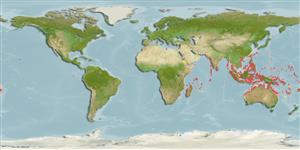Hexacorallia |
Scleractinia |
Acroporidae
Environment: milieu / climate zone / εύρος βάθους / distribution range
Οικολογία
Υφαλόφιλο(α); εύρος βάθους 1 - 12 m (Αναφ. 98471). Tropical; 36°N - 31°S, 30°E - 124°W (Αναφ. 846)
Indo-Pacific: from Japan (north) and south to Australia and South Africa and east to Pitcairn Islands.
Length at first maturity / Μέγεθος / Weight / Age
Γεννητική Ωρίμανση: Lm ? range ? - ? cm Max length : 300 cm COLD αρσενικό/απροσδιόριστο; (Αναφ. 846)
Found around low tide mark and subtidally on rocky, wave-swept shallow reefs and reef habitats subject to strong tidal currents (Ref. 86439). Also on upper reef slopes (Ref. 98471).
Life cycle and mating behavior
Γεννητική Ωρίμανση | Αναπαραγωγή | Γεννοβολία | Eggs | Γονιμότητα | Larvae
Members of the class Anthozoa are either gonochoric or hermaphroditic. Mature gametes are shed into the coelenteron and spawned through the mouth. Life cycle: The zygote develops into a planktonic planula larva. Metamorphosis begins with early morphogenesis of tentacles, septa and pharynx before larval settlement on the aboral end.
Veron, J.E.N. 2000 Corals of the world. Volume 1. Australian Institute of Marine Science and CRR Qld. Pty. Ltd. Australia. 463 p. (Αναφ. 846)
IUCN Red List Status
(Αναφ. 130435: Version 2025-1)
CITES status (Αναφ. 108899)
Not Evaluated
Threat to humans
Human uses
| FishSource |
Εργαλεία
Περισσότερες πληροφορίες
Τροφική ΟικολογίαFood items (preys)
Σύσταση δίαιτας
Κατανάλωση τροφής
Θηρευτές
Population dynamicsΑύξηση
Max. ages / sizes
Length-weight rel.
Length-length rel.
Length-frequencies
Mass conversion
Αφθονία
Life cycleΑναπαραγωγήΓεννητική ΩρίμανσηΓονιμότηταΓεννοβολίαEggsEgg developmentLarvae PhysiologyΚατανάλωση οξυγόνου
Human RelatedStamps, coins, misc.
Διαδικτυακές πηγές
Estimates based on models
Preferred temperature
(Ref.
115969): 25 - 29.3, mean 28.5 (based on 2986 cells).
Fishing Vulnerability
Very high vulnerability (90 of 100).
Price category
Unknown.
